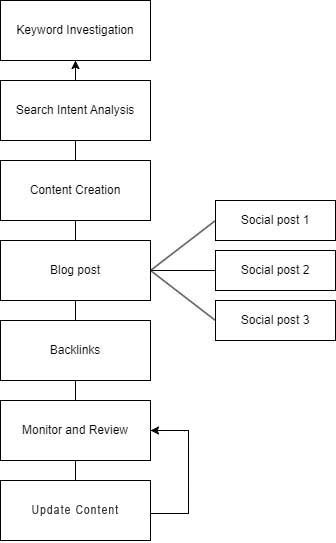As we move into 2025, the focus has shifted from isolated tactics to a holistic approach that builds authority, lifts organic clicks across your site, and delivers consistent results over time.
If you’re a B2B business struggling to get traction online, this guide will show you how to implement an online website marketing strategy that works, one built on planning, consistency, and proven methods.

Why You Need a Solid Online Marketing Strategy
As a business owner, you’ve likely dabbled in online marketing but haven’t seen the results you hoped for. Maybe your website isn’t attracting the right visitors, or perhaps you’re unsure of how to convert interest into action. That’s where a structured approach, centred around SEO, content, and analytics, can make all the difference. Let’s dive into how Webstudio’s holistic strategies can help you turn your online presence into a growth engine.

1. Start with Keyword Investigation
The foundation of any good strategy is understanding what your audience is searching for. By identifying the right keywords, you can align your content with what your potential customers need. Here’s how we approach it:
- Use the Google Ads Keyword Tool: Whether you run ads or not, this tool is invaluable for finding search terms with low competition and high relevance to your business.
- Focus on Long-Tail Keywords: These specific phrases often have lower competition and higher intent, making them ideal for attracting quality traffic.
- Analyse Competitor Data: See what’s working for others in your industry and identify gaps you can fill with better, more targeted content. Spyfu.com is great for this.

2. Understanding Search Intent
Search intent is the why behind a search query. Are users looking for information, comparing options, or ready to buy? Tailoring your content to match their intent ensures you’re meeting their needs at every stage of the journey.
- Informational Intent: Create guides, how-tos, or explainer content.
- Navigational Intent: Make sure your brand pages are easy to find.
- Transactional Intent: Optimise pages for conversions, like “Contact Us” or “Buy Now.”
- Commercial Investigation: Publish comparison articles or reviews to position yourself as the best option.
By aligning your content with intent, you not only attract traffic but engage visitors who are more likely to convert.

3. Build Topic Clusters Around Pillar Pages
To improve organic clicks across your site, categorisation is key. We create pillar pages - comprehensive guides on key topics - supported by cluster content that dives into related subtopics.
Why It Works:
- Pillar Pages Build Authority: These broad-topic guides establish your expertise and serve as a central hub for related content.
- Cluster Content Boosts Relevance: Supporting articles link back to the pillar, making your site more valuable to search engines.
- Internal Linking Enhances Navigation: Proper linking helps search engines understand your site structure and makes it easier for users to explore relevant content.
Optimising for Featured Snippets:
To target the AI-driven summaries often shown at the top of search results, also known as featured snippets, it's important to write content in a way that directly answers questions or provides concise, structured information.
- Include FAQ Sections: Featured snippets frequently draw from FAQ-style content that provides direct answers. Use headers like H2 or H3 for each question.
- Use Structured Data: Ensure your content is formatted with clear headings, bullet points, or numbered lists to make it easier for search engines to parse.
- Be Concise and Specific: Answer questions in 40-60 words where possible. For example, if targeting “What is Business Automation?”, start with a clear, focused definition followed by supporting details.
- Add Definitions and Summaries: At the top of your pillar pages or cluster content, include a succinct paragraph summarising the page's key points.
Example in Action:
If your pillar page is “The Ultimate Guide to Business Automation”, include a section like:
What is Business Automation?
Business automation refers to using technology to streamline repetitive tasks, improve efficiency, and save time, enabling businesses to focus on strategic growth.
This approach not only improves the chances of your content being featured in a snippet but also helps users and search engines quickly grasp your content’s relevance.
Example Structure:
If you’re a B2B business selling software, your pillar page might be “The Ultimate Guide to Business Automation”, supported by cluster articles like:
- “Top Automation Tools for Small Businesses”
- “How Automation Saves Time”
- “Automation vs Manual Processes: Which is Better?”
These strategies collectively establish your authority, improve SEO, and enhance your site’s chance of dominating search engine results, including the coveted featured snippet position.

4. Create and Repurpose Content
Content creation isn’t just about writing - it’s about making every piece of content work harder for your business. A single well-crafted blog post can fuel multiple marketing channels, engaging your audience wherever they are and driving consistent results. Whilst you dont have to do all of these, they are kind of guiding you towarsds the art of the possible.
Weekly Blog Posts: Start with high-quality, unique content written by experts. Incorporate your target keywords strategically into the title, headings, URL, and first paragraph to maximise SEO impact and relevance.
Social Media: Break your blog posts into smaller, engaging snippets for platforms like LinkedIn, Facebook, and Instagram. Each article can fuel up to five social posts, keeping your social media presence consistent and your audience engaged.
Email Campaigns: Share your blog posts with your email subscribers, providing value while keeping your business top of mind. For B2B businesses, GDPR-compliant cold email campaigns can extend your reach, targeting new prospects with helpful content and building relationships.
Downloadable PDFs: Transform comprehensive blogs into downloadable guides, which you can use for email capture through information swaps. These resources offer added value while growing your email list.
Short-Form Videos: Repurpose your content into bite-sized videos for YouTube Shorts, Instagram Reels, and LinkedIn. Use simple tools to add captions, intros, and outros to make them professional yet personal. Keep your branding consistent with recognisable thumbnails and a clear visual style.
Long-Form Videos: Expand on your blog topics in longer video formats for YouTube or LinkedIn. A well-thought-out video can position your business as an authority in your field while reaching audiences who prefer visual content.
Presentations and Webinars: Use your content as the foundation for webinars, online presentations, or even in-person workshops. This allows you to connect directly with your audience while repurposing your written work.
Paid Ads: Leverage key snippets or highlights from your blogs in Google Ads or social media ad campaigns. Well-optimised content can drive traffic to your website while reinforcing your expertise.
Infographics: Condense your blog’s key points into visually appealing infographics. These are great for sharing on social media and within emails to engage visual learners.
Podcast Episodes: If relevant, turn your blog topics into short podcast episodes. Discuss key insights, invite guest speakers, or answer common audience questions to keep your content dynamic and accessible.
By repurposing content across multiple channels, you ensure a consistent message, increasing your reach, and maximise the return on your content investment. Whether it’s a blog post, a social snippet, or a downloadable guide, your content works harder, smarter, and longer to grow your business.
Useful Tool: Topical Map Generator for SEO
Use our Topical Map Generator to discover the perfect cluster topics for your SEO strategy and take the guesswork out of content planning. Try it now!

Tools like Google Analytics and Search Console are your secret weapons for understanding what’s working.
- Track Search Terms: See what queries are bringing visitors to your site. Are they aligned with your goals?
- Refine Content: If certain terms perform well, create more cluster content around them to boost your authority.
- Focus on Impressions First: Growth starts with more visibility. As your rankings improve, clicks will follow.

Building an online presence takes time. You won’t hit page one on day one, but with consistent effort, results will come. Align your content strategy with your seasonal marketing calendar to ensure your efforts support broader business goals.
Consider the “Free, Free, Fee” approach to email marketing:
- Send two informative emails with no sales pitch.
- Follow up with a third email offering a product or service.
This keeps your audience engaged while gently guiding them toward conversion.

2025 is the year to take control of your online presence with a proven, holistic strategy. At Webstudio, we specialise in creating results-driven marketing plans that help B2B businesses thrive. Whether you’re starting from scratch or need to refine your current approach, we’re here to guide you every step of the way.
Let’s chat and create a strategy tailored to your business goals. Get started today and make 2025 your breakthrough year!

1. Why is keyword research important for my online website marketing strategy?
Keyword research helps you understand what your potential customers are searching for, allowing you to create content that meets their needs and improves your search rankings.
2. How often should I update my website content?
Regularly! Aim to update your content at least once a month to keep it relevant and engaging for both users and search engines.
3. What’s the difference between pillar and cluster content?
Pillar content is a comprehensive guide on a broad topic, while cluster content consists of specific blog posts that support and link back to the pillar, creating a strong SEO structure.
4. How can I build backlinks effectively?
Reach out to related websites for guest posts, participate in online communities, and create valuable content that others want to link to.
5. How do I track the success of my online website marketing strategy?
Use tools like Google Analytics and Search Console to monitor your website’s performance, track keyword rankings, and adjust your strategy based on the data.
This content is downloable
Online Website Marketing Strategy for 2025: A Holistic Approach to Boosting Your Online Presence

Author
Technical Director
With over 20 years of experience in building and promoting websites, Neil is a seasoned expert in digital marketing and SEO. Passionate about helping businesses grow through innovative web solutions, Neil has successfully built over 400 websites.

